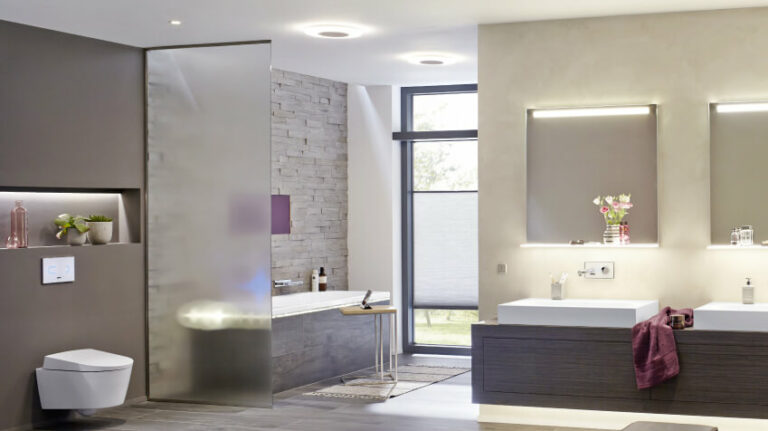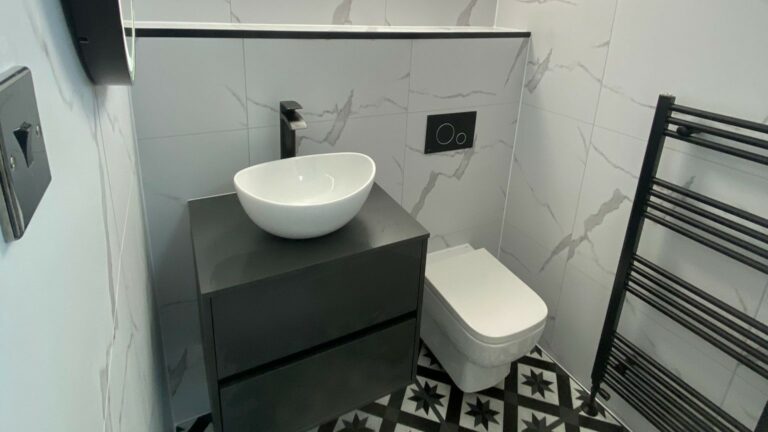Choosing the right bathroom floor tiles is essential for creating a beautiful, safe, and long-lasting bathroom. With so many options available, it can be challenging to know what to consider when selecting tile flooring for bathrooms. In this article, we’ll guide you through how to choose tiles for bathroom floors by exploring important factors like material, style, and the latest bathroom tile trends. Plus, we’ll help you answer the question: what is the best tile for bathroom floors?
Why Bathroom Floor Tiles Matter
Bathroom floors face constant moisture, foot traffic, and cleaning challenges. The right tile flooring for bathrooms should be water-resistant, durable, slip-resistant, and complement your overall design aesthetic. Choosing the right tiling can significantly enhance the aesthetic appeal of your bathroom, creating a visually pleasing space while offering practical benefits like easy maintenance and long-lasting durability. The wrong choice could lead to slippery surfaces, water damage, or high maintenance needs.
How to Choose Tiles for Bathroom: Key Factors to Consider
1. Best Material for Bathroom Floor Tiles
Understanding the different materials available is the first step to making an informed choice:
- Porcelain and Ceramic Tiles: These are among the most popular choices because they are durable, water-resistant, and available in numerous styles. Porcelain is denser and less porous, making it ideal for wet environments.
- Natural Stone Tiles: Marble, granite, slate, and travertine offer luxury and unique patterns but require sealing and more maintenance to prevent staining and water damage.
- Vinyl and Luxury Vinyl Tiles (LVT): Waterproof and soft underfoot, vinyl tiles are increasingly popular due to easy installation and affordability.
- Glass Tiles: Mostly used for accents, some textured glass tiles are suitable for floors but generally less common.
Many homeowners opt for porcelain and ceramic as the best tiles for bathroom floors due to their superior durability, water resistance, and wide variety of styles.
2. Consider Slip Resistance
Safety is crucial in wet areas like bathrooms. Look for tiles with high slip resistance ratings. Textured finishes or matte tiles provide better grip than glossy surfaces, reducing the risk of slips and falls.
3. Size, Shape, and Layout
Bathroom tile trends increasingly favor larger-format tiles. These tiles reduce grout lines, which makes floors easier to clean and creates a sense of spaciousness. However, smaller tiles and mosaics are popular for shower floors because they provide more grip.
Experimenting with shapes like hexagons or geometric patterns is also trendy and can add a modern touch to your bathroom floor.
Incorporating multiple colors in your tile layout can create a dynamic and cohesive design, especially when you select a harmonious color palette or use colors from patterned tiles to balance consistency across different areas.
4. Color and Design
Choosing the right color and pattern is key for tying your bathroom together. For example, blue can create a calming or traditional atmosphere, making it a popular choice in many bathroom designs. Neutral shades such as gray, beige, and white remain timeless and versatile. For a bold statement, patterned tiles or wood-look tiles are gaining popularity in bathroom tile trends.
Shower Area Design: Special Considerations for Wet Zones
The shower area is the heart of any bathroom, and its design requires special attention due to the constant exposure to water and humidity. Choosing the right bathroom tiles for this high moisture environment is essential-not only for durability and water resistance but also for creating a space that feels both inviting and stylish.
Porcelain and ceramic tiles are standout choices for shower floors and walls. Their dense, non-porous nature makes them exceptionally water-resistant, ensuring your shower area remains protected against moisture damage. Porcelain tiles, in particular, are renowned for their durability and ease of maintenance, making them a practical yet elegant solution for wet zones.
For those seeking a touch of luxury and timeless appeal, marble tiles or other natural stone options can transform a shower into a sophisticated retreat. White marble, with its classic beauty, brings a sense of elegance and light to the space. However, natural stone requires a bit more care-properly sealing grout lines and the stone itself is crucial to prevent water from seeping behind the tiles and to maintain the pristine look of your shower over time.
Design elements play a significant role in the overall aesthetic of your shower area. Incorporating natural textures, such as stone or wood-look porcelain tiles, adds warmth and character, while unique shapes and patterns-like hexagons or chevrons-can create an impactful statement. When selecting tiles, consider the width and length to ensure they complement the proportions of your shower. Larger tiles can make a compact shower feel more spacious, while smaller mosaics offer extra grip and visual interest.
Color choices also influence the mood of your shower. Subtle hues like soft blues and grays evoke a calming, spa-like atmosphere, while bolder patterns or a decorative backsplash can serve as a striking focal point. Mixing textures and finishes-matte with glossy, smooth with textured-adds depth and sophistication to the design.
Ultimately, a well-designed shower area balances function and beauty. By carefully selecting bathroom tiles, paying attention to grout and maintenance, and embracing endless design possibilities, you can create a shower that not only stands up to daily use but also elevates the entire bathroom. Whether you’re renovating or building new, thoughtful tile choices in the shower area will ensure your bathroom remains a timeless and elegant sanctuary for years to come. If you’re looking for complete bathroom packages, Simply Group offers bundled services that include flooring, tiling, and fixture installation to simplify the process.
What Is the Best Tile for Bathroom Floors?
If you’re wondering what is the best tile for bathroom floors, porcelain tiles are often the top recommendation by experts. They combine water resistance, durability, and an extensive variety of designs and finishes. Porcelain tiles can mimic natural stone, wood, or even concrete, making them a versatile choice that fits most design schemes.
Ceramic tiles are also excellent, especially for those on a budget, offering good durability and water resistance.
Natural stone tiles offer beauty and uniqueness but require more upkeep. Vinyl tiles, while not traditional tile, provide excellent waterproof qualities and comfort underfoot for modern bathrooms.
To achieve a complete and polished look, make sure to follow proper installation steps, including grouting and sealing, so your bathroom floor is both beautiful and durable. Hiring experts for your bathroom installation ensures these steps are done correctly for long-lasting results.
Latest Bathroom Tile Trends to Inspire You
Keeping up with bathroom tile trends ensures your design feels fresh and modern:
- Large Format Tiles: Oversized tiles minimize grout lines, creating a sleek and spacious look.
- Wood-Look Tiles: Porcelain tiles that resemble wood bring warmth to bathroom floors without the downsides of real wood.
- Textured and 3D Tiles: Adding texture creates depth and enhances grip, combining aesthetics and safety.
- Bold Patterns: Geometric and encaustic-style tiles add personality and act as a focal point.
- Matte Finishes: Moving away from glossy tiles, matte finishes are trending for their modern appeal and slip resistance.
- Backsplashes: Backsplashes are increasingly popular as both functional and decorative features, protecting walls behind sinks and in shower areas while enhancing overall bathroom design.
- Tiled Bathroom Walls: Tiling bathroom walls with stylish options like fluted, porcelain, or ceramic tiles is a growing trend, offering both durability and a visually appealing surface.
Maintenance Tips for Bathroom Floor Tiles
Proper maintenance ensures your bathroom floor tiles stay beautiful for years. Regular sweeping and mopping with mild cleaners prevent dirt buildup. Avoid abrasive chemicals that can damage grout or tile finishes. For natural stone tiles, periodic sealing is essential to maintain water resistance and prevent stains.
Final Thoughts on How to Choose Bathroom Floor Tile
Choosing the right bathroom floor tiles is a balance between style, durability, and safety. Understanding how to choose tiles for bathroom floors based on material, slip resistance, size, and design helps you pick the best option that suits your lifestyle and aesthetic preferences.
When considering tile flooring for bathrooms, porcelain tiles often emerge as the best all-around choice for their performance and versatility. However, the final decision depends on your budget, design goals, and maintenance expectations.
Incorporating current bathroom tile trends such as large-format tiles, wood-look patterns, or textured finishes can elevate your bathroom’s style while ensuring functionality.
If you’re looking for further help selecting the best bathroom products, book an appointment with The Simply Group. Experts in all home improvements, we can help turn your dream bathroom into a reality. Check out our wide range of bathroom products that Simply Group have to offer on our online brochure.



